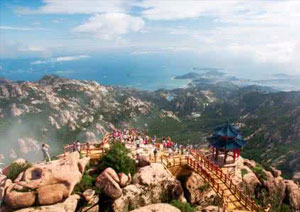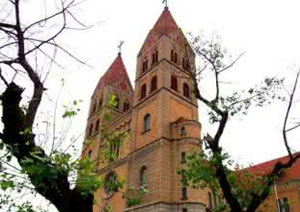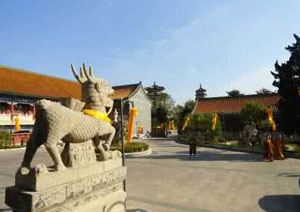
Qingdao Confucius Temple is for consecrating and worshipping Confucius, the great thinker and educator of ancient China. The Confucius Temple (Fuzimiao) was originally built during the Song Dynasty and is situated on the north bank of the Qinhuai River. The Song Dynasty was a period of great Confucian revivalism and the temple here is considered to be one of the best preserved of its type in China. During the Ming Dynasty the temple was expanded and became a school for children of the imperial court. The buildings on both sides of the Temple which are now small tourist shops were once individual study rooms for Confucian scholars.
 Located by the seaside of the Yellow Sea, the 1,133-meter-high Mt. Laoshan is known as the No.1 religious mountain along China's coastline and the birthplace of Taoism. It is situated in the south part of Shandong peninsula and northeast of Qingdao urban area. Of marine climate in Temperate Zone, the area has an annual average temperature of 12.6 degree centigrade and precipitation between 940 to 1073 millimeters, the most humid part of Qingdao City. The area consists of 9 scenic sites and 5 resumed scenic sites as well as coastal scenic sites. There are altogether 220 places of interest around a mountainous coast of 87.3 kilometers.
Located by the seaside of the Yellow Sea, the 1,133-meter-high Mt. Laoshan is known as the No.1 religious mountain along China's coastline and the birthplace of Taoism. It is situated in the south part of Shandong peninsula and northeast of Qingdao urban area. Of marine climate in Temperate Zone, the area has an annual average temperature of 12.6 degree centigrade and precipitation between 940 to 1073 millimeters, the most humid part of Qingdao City. The area consists of 9 scenic sites and 5 resumed scenic sites as well as coastal scenic sites. There are altogether 220 places of interest around a mountainous coast of 87.3 kilometers.
 The Ba Da Guan (Eight Passes Scenery Spot), a sanatorium area in Qingdao lies in the east of Huiquan Bay. It is well known for its photogenic landscaping and the amalgam of more than 200 western architectures in different styles, and is also called the Architecture Museum.
The Ba Da Guan (Eight Passes Scenery Spot), a sanatorium area in Qingdao lies in the east of Huiquan Bay. It is well known for its photogenic landscaping and the amalgam of more than 200 western architectures in different styles, and is also called the Architecture Museum.
With its colonial, predominantly German, history Qingdao contains the architecture of many different European styles. Outside of the old German Concession, north of the railway station, most of this history is displayed in Badaguan, also known as the Huiquan area. Badaguan, literally the Eight Passes, is so named because eight of the roads here are named after China's most famous passes.
 Built in the 1930's, Zhan Shan Temple is situated at the foot of Zhan Shan Hill and to the east of Taiping Hill. It is the youngest famous Buddhist Temple in China. Covering an area of about 32 acres, the temple is divided into four sections with three court yards. It has five halls and a pagoda, with an area of 20,000 square meters.
Built in the 1930's, Zhan Shan Temple is situated at the foot of Zhan Shan Hill and to the east of Taiping Hill. It is the youngest famous Buddhist Temple in China. Covering an area of about 32 acres, the temple is divided into four sections with three court yards. It has five halls and a pagoda, with an area of 20,000 square meters.
The temple boasts a large collection of skillfully carved statues of Buddha and Buddhist scriptures. There are ten thousands of people at Zhan Shan Temple from 8th to 10th in April on the lunar calendar every year.
| Qingdao Attractions List | |

